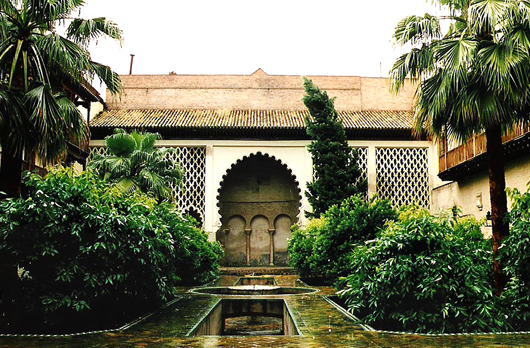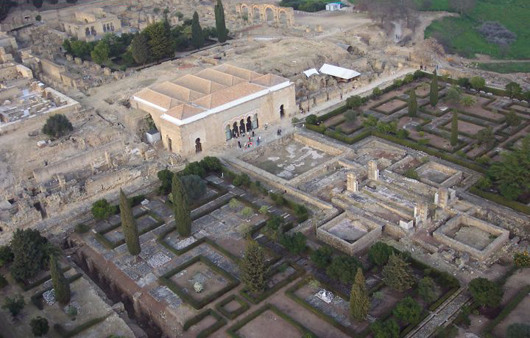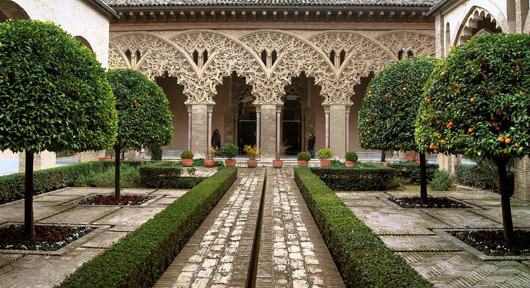Domestic living spaces are arranged around a courtyard, usually gardened, which is the "dejennat", "pharadaisos" or Home paradise, where the believer lives a celestial paradise premonition.
Large halls in Medina Azahara are located in some cases, as Abd-Al-Rahman II Hall, in an artificial terrace, built on strong walls holding a high garden with views to lower gardens and general landscape, trying to evoke the Babylon Hanging Gardens. West Hall palace stands on a paradise placed at its feet which is crossed y two cruciforms roads with pools or pavilions in its intersection. This is cross garden model, from Iranian origin like the garden planted by Cyrus the Younger himself, the great Persian warrior and prince as described by Xenophon. This garden was discovered by Deutsehe Archaeologisque Institut and is the oldest crossed garden known.
Palatine town of Medina Azahara (936-976). General plan showing gardens.
Palatine town of Medina Azahara (936-976). Plan of Eastern Garden.
Palatine town of Medina Azahara (936-976). Longitudinal Section of Eastern Garden.
Palatine town of Medina Azahara (936-976). Transverse Section of Eastern Garden.
Palatine town of Medina Azahara (936-976). Aerial view of Eastern Garden.
This garden type arrived later to Islam, and we first find it in Ruzafa Palace in Syria, built during the reign of Hisham I, last Umayyad caliph. Abbasids built similar courtyards in Balkuwara palaces in Samarra. Abd al-Rahman I, Hisham I grandson, copied Ruzafa palace and garden near Córdoba. Turruñuelo, a framhouse close to Medina Azahara identifiable by photogrammetric was the model for later Hispanic crossed gardens.


General scheme of Sardis Gardens (Turkey, 6th c. B. C.)
Scheme of Hixem I's Cross Garden in Rezafa, Siria (7th c.)
Rafael Manzano excavated and made a garden anastylosis in Medina Azahara, known as Prince or Alberquilla Garden, which is the most perfect model of later andalusian houses. This courtyard, slightly rectangular, has two lateral walls in its longer sides. There are two pavilions in its two smaller sides, located at West and East. These pavilions consist on a long hall with lateral alcoves, some fictional, and preceded by a porch, enclosed by a gate with a triple horseshoe arches between two columns.
 Palatine town of Medina Azahara (936-976). Alberquilla Court.
Palatine town of Medina Azahara (936-976). Alberquilla Court. Aljafería Palace, Zaragoza (1065-1081). Plan of taifa palace.
Aljafería Palace, Zaragoza (1065-1081). St. Isabel Court.
Real Alcázar de Sevilla. General plan showing gardens.
Real Alcázar de Sevilla. Almohad rooms known as Patio del Yeso (12th c.). Plan.
 Real Alcázar de Sevilla. Almohad rooms known as Patio del Yeso (12th c.). Plan.
Real Alcázar de Sevilla. Almohad rooms known as Patio del Yeso (12th c.). Plan. Real Alcázar de Sevilla. Almohad Palace in Casa de Contratación, almohad and current plan.
Real Alcázar de Sevilla. Almohad Palace in Casa de Contratación, virtual reconstruction.
Real Alcázar de Sevilla. Almohad Palace in Casa de Contratación, North elevation in Almohad times.
Real Alcázar de Sevilla. Almohad Palace in Casa de Contratación; southern portico.
 Real Alcázar de Sevilla. Almohad Palace in Casa de Contratación; northern portico.
Real Alcázar de Sevilla. Almohad Palace in Casa de Contratación; northern portico. Real Alcázar de Sevilla. Transverse Section of Patio de las Doncellas in Pedro I Palace (1356-1366).
Real Alcázar de Sevilla. Transverse Section of Patio de las Doncellas in Pedro I Palace (1356-1366). Real Alcázar de Sevilla. Patio de las Doncellas in Pedro I Palace (1356-1366).
Real Alcázar de Sevilla. Patio de las Doncellas in Pedro I Palace (1356-1366). Real Alcázar de Sevilla. Longitudinal Section of Patio de las Doncellas in Pedro I Palace (1356-1366).
Real Alcázar de Sevilla. Longitudinal Section of Patio de las Doncellas in Pedro I Palace (1356-1366). Real Alcázar de Sevilla. Patio de las Doncellas in Pedro I Palace (1356-1366).
Real Alcázar de Sevilla. Patio de las Doncellas in Pedro I Palace (1356-1366).Lecture by D. Rafael Manzano Martos on November 17, 2010 at the School of Architecture at the University of Notre Dame, USA
























Extraordinario artículo. Si se me permite citaré esta pàgina en mi modesto blog (incluyendo un enlace) y reproduciré alguna de las magníficas ilustraciones que usted incluye, puesto que deseo hacer una muy breve y mucho menos docta referencia a los jardines persas y al jardín de Ciro en Sardes. Le felicito muy encarecidamente por su interesantísimo blog y le agradezco profundamente su trabajo.
ResponderEliminarMuchas gracias por su amable comentario. Puede encontrar más artículos de la misma temática tanto en inglés como en castellano y enlazar cuantos textos e imágenes desee. Un saludo.
Eliminar